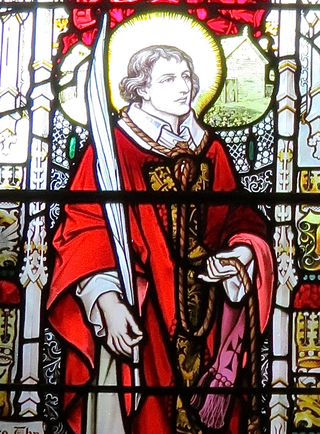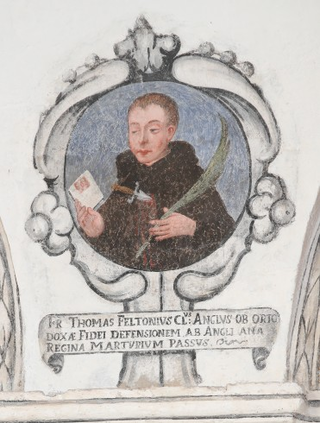John Hambley (died 1587) was an English Catholic and martyr, who died during the reign of Elizabeth I.
John Hambley was a native of the parish of St. Mabyn, near Bodmin, Cornwall. Hambley was converted to Catholicism by reading one of Robert Persons' books in 1582. Around Christmas that year he ceased to attend the worship established by law, and fearing the penalty entailed by absence from church decided to leave the county where he was known. He journeyed to London, where he took up abode at the "Sun and Seven Stars" in Smithfield until May 1583. During that time he was reconciled to the Catholic faith in a chamber over the gate at the "Red Lion" in Holborn by Mr. Fortescue, a seminary priest staying there. [1]
In early May 1583 he sailed from Rye in Sussex for Dieppe, arriving at Rheims by way of Rouen by the end of the month. He studied at Rheims and was ordained a priest 22 September 1584. Disguised as a serving man he left with Maurice Williams for the English Mission on 6 April 1585. Landing near Ipswich, they made his way to London taking up residence in the "Blue Boar". A fortnight later Hambley relocated to the "Red Lion", placing himself under the direction of the Catholic priest John Cornelius. During this time, he ministered to some of the clandestine Catholics at the Inns of Court. After about five weeks he then went to Dorsetshire and worked in the Western Counties for about a year. [1]
Around Easter 1586, he was denounced by a gentleman's servant who had once been his fellow-lodger. He was captured, then tried and condemned at Taunton; however, he denied his faith for a reprieve and then broke prison. Having fled to Salisbury, he continued his labours there until the next August. Then, on the eve of the Assumption, the Protestant Bishop of Salisbury decided to search the houses of local Catholics, suspecting that he might catch a priest saying mass. During the raids Hambley was recaptured. Now worse off than ever, he became even more afraid than before and gave up the names of most of his Catholic friends, as well as denied his faith. However, the judges did not trust his statements and he was held over for the next assizes. Then, on the next Easter, he was tried again. This third time though, he did not break, and was executed near Salisbury, "standing to it manfully, and inveighing much against his former fault". [2]
No one is sure what caused him to stand firm during his final arrest. One contemporary, Father Warford, believed it was due to his guardian angel, but another, Father Gerard, with great probability, states that his strength came from a fellow prisoner, Thomas Pilchard, who later became a martyr himself. [2]
George Nichols was an English Catholic martyr.
John Adams was an English Catholic priest and martyr.
John Lowe (1553–1586) was an English Catholic priest and martyr.
Robert Dibdale was an English Catholic priest and martyr.

Robert Dalby was an English Catholic priest and martyr.
The Dryburne Martyrs: Richard Hill, Richard Holiday, John Hogg and Edmund Duke were English Roman Catholic priests and martyrs, executed at Dryburne, County Durham, in the reign of Elizabeth I. They were beatified by Pope John Paul II in 1987.

Roger Filcock, SJ was an English Jesuit priest. He was beatified as a Catholic martyr by Pope John Paul II on 22 November 1987.
Nicholas Garlick was an English Catholic priest, martyred in Derby in the reign of Queen Elizabeth I.

Richard Gwyn, also known by his anglicized name, Richard White, was a Welsh teacher at illegal and underground schools and a bard who wrote both Christian and satirical poetry in the Welsh language. A Roman Catholic during the reign of Queen Elizabeth I of England, Gwyn was martyred by being hanged, drawn and quartered for high treason at Wrexham in 1584. He was canonized by Pope Paul VI in 1970 as one of the Forty Martyrs of England and Wales. Since its creation in 1987, St. Richard Gwyn has been the Patron Saint of the Roman Catholic Diocese of Wrexham. Along with fellow lay martyr St. Margaret Clitherow, Gwyn is the co-patron of the Latin Mass Society of England and Wales.

Edward James was an English Catholic priest and martyr.

Richard Simpson was an English priest, martyred in the reign of Elizabeth I. He was born in Well, in Yorkshire. Little is known of his early life, but according to Challoner's Memoirs of Missionary Priests, he became an Anglican priest, but later converted to Catholicism. He was imprisoned in York as a Catholic recusant; on being released, he went to Douai College, where he was admitted on 19 May 1577. The date of his ordination is unknown; the college, at this time, was preparing for its move to Rheims, and record keeping was affected. But it is known that the ordination took place in Brussels within four months of his admission to the seminary, and that on 17 September, Simpson set out for England to work as a missionary priest. He carried out his ministry in Lancashire and Derbyshire.
John Bodey was an English Catholic academic jurist and lay theologian. He was martyred in 1583, and beatified in 1929.
Thurston Hunt was an English Catholic priest. He was tried and executed with Robert Middleton, also a priest. They were declared to be martyrs by the Catholic Church, and beatified in 1987, by Pope John Paul II.

George Haydock was an English Roman Catholic priest. He is a Catholic martyr, beatified in 1987. He is not to be confused with his relative, also a priest, George Leo Haydock (1774–1849).
Edward Stransham was an English Roman Catholic priest. He is a Catholic martyr, beatified in 1929.
William Spenser was an English Roman Catholic priest. He is a Catholic martyr, beatified in 1987.
John Thulis (also spelt Thules, Thewlis) (c. 1568 – 18 March 1616) was an English Roman Catholic priest. Beatified in 1987, he is one of the Douai Martyrs.

The Oaten Hill Martyrs were Catholic Martyrs who were executed by hanging, drawing and quartering at Oaten Hill, Canterbury, on 1 October 1588. The gallows had been put up in 1576. These four were beatified by Pope Pius XI in 1929.
Richard Martin was an English martyr. A layman, Martin was charged with being a "receiver and maintainer of priests" for having bought supper for Robert Morton, a priest.

Thomas Felton (1566?–1588) was a Franciscan Minim, a Roman Catholic martyr and son of the Roman Catholic martyr, John Felton.